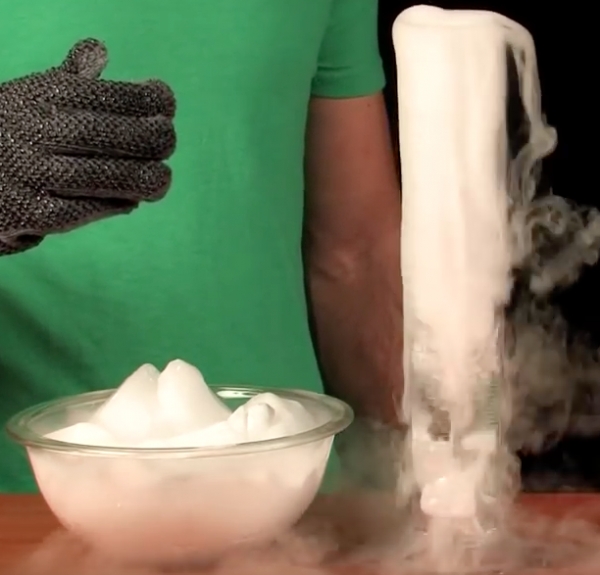
We know that dry ice is incredibly fun to use in experiments – it’s because of the awesome fog you get when you combine the ultra-cold ice with warm water! Do you think if you could actually grab and hold that elusive smoke in your hands? With the Dry Ice Smoking Bubbles experiment, you can! By creating smoke-filled bubbles that you can hold in your hands, you make dry ice a fun experience that everyone can really “grasp.”
드라이 아이스가 과학실험에 사용하기에 정말 재미있는 재료가 된다는 것은 여러분도 잘 아시죠. 이것은 정말 차가운 드라이 아이스와 따뜻한 물이 만나면 멋진 안개를 만들어 내기 때문이예요. 자 그럼 쉽게 빠져나가는 연기를 여러분의 손으로 잡아볼 수 있을까요? 이번 연기나는 공기방울 실험을 통해 여러분은 할 수 있어요. 손으로 잡을 수 있는 연기로 가득한 공기방울을 만듦으로써 정말 잘 이해할 수 있는 드라이아이스 과학 실험을 즐겨보세요.
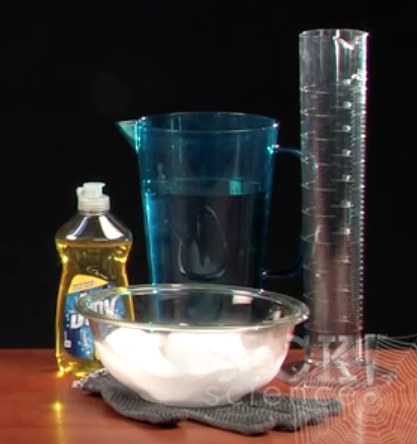
■ Things you need (필요한 것들)
•Graduated cylinder (or similar container) 과학용 눈금 실린더 또는 유사한 병
•Warm water 따뜻한 물
•Dry ice 드라이 아이스
•Dish soap 주방 세제
•Heavy glove 두꺼운 장갑
•Safety glasses 보호 안경
•Food coloring (optional) 식용 색소 (선택사항)
•Adult Supervision 어른의 감독
■ Procedures (실험절차)
NOTE: Before handling any dry ice, put on a pair of heavy gloves. Dry ice is so cold (-110ºF/-78ºC) that it will burn your skin!
주의 : 드라이 아이스를 만지기 전에는 꼭 두꺼운 장갑을 껴야해요. 드라이 아이스는 너무 차가워서 (화씨 -100도, 섭씨 -78도) 손을 태워버릴 수도 있어요.
1. Fill your graduated cylinder half-full with warm water. If you don’t have a graduated cylinder laying around, you can use something similar, like a flower vase or another tall, narrow container. 눈금 실린더에 따뜻한 물을 채워주세요. 집에 눈금 실린더가 없다면 꽃병이나 그와 비슷한 길고 얇은 용기를 사용하셔도 되요.
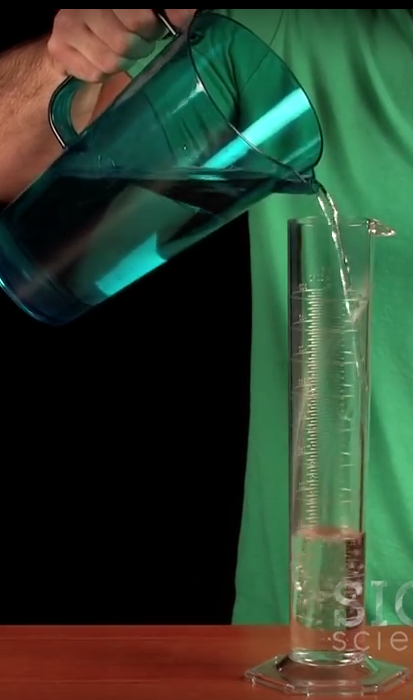
2. Make sure that you have pieces of dry ice that are small enough to fit inside your graduated cylinder. If not, put on a pair of safety glasses and use a hammer to break the dry ice into smaller pieces. 드라이 아이스가 눈금실린더 안에 들어 갈 수 있는 만큼 조그만 크기인지 확인하세요. 만약 그렇지 안다면 보호 안경을 쓰고 망치를 이용해서 드라이 아이스를 작은 조각으로 부숴주세요.
3. Once you’ve created the small pieces, drop a few into the graduated cylinder. Once in the water, the dry ice will begin to bubble and produce a smoke within the cylinder. Eventually the smoke flows right over the top. 이렇게 작은 드라이 아이스 조각이 만들어 지면 몇 조각을 눈금 실린더에 넣어주세요. 물에 들어가게 되면 드라이 아이스가 방울을 만들기 시작하면서 실린더 안에서 연기가 나기 시작할 거예요. 결국에 이 연기가 실린더 밖으로 넘쳐 나올거예요.
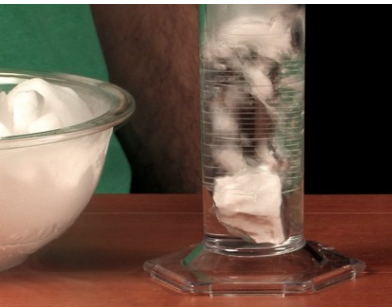
4. Put a squirt of dish soap into the cylinder and watch what happens! Before you know it, a column of bubbles begins to form at the mouth of your cylinder. 이때 주방 세제 한방울을 실리더 안에 떨어뜨려 주고 어떤일이 생기는지 관찰해 보세요. 모르는 사이에 공기방울 기둥이 실리던 입구쪽에 만들어지기 시작할 거예요.
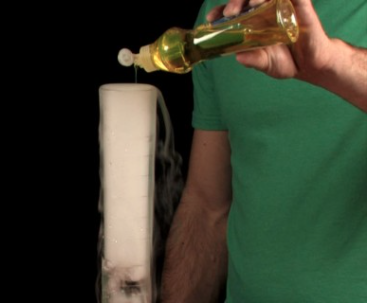
5. Grab those bubbles and give them a squeeze! These bubbles burst with an amazing explosion of fog. 이 공기방울을 손에 넣고 손을 꼭 잡아보세요. 이 공기방울이 안개같은 연기로 폭발할 거예요.

■ Scientific Explanation (과학적 설명)
When you add dry ice to warm water, you immediately see the dry ice begin to bubble and create fog within the container. This “smoking” effect is directly caused by the rapid warming of the dry ice. Dry ice is frozen, compressed carbon dioxide gas and when you add it to warm water, it combines with the water to create the fog (carbon dioxide and water vapor) that you see bubbling out of your cylinder.
드라이 아이스를 따뜻한 물에 넣게 되면 드라이 아이스가 바로 거품이 되면서 용기 안에서 연기를 만들어 내는것을 보게 될거예요. 이러한 연기나는 현상은 드라이 아이스가 빠른 속도로 따뜻해 지면서 생겨나는 것이예요. 드라이 아이스는 아주 차갑게 압축된 이산화탄소 가스예요 그래서 이것을 따뜻한 물에 넣게 되면 물과 결합하게 되어 연기를 만들게 되는데 (이산화 탄소와 수증기) 이것이 바로 실린더 밖으로 흘러나오는 거품들이예요.
Adding soap to burping, bubbling, smoking water creates a whole new effect. Instead of the dry ice just bubbling in the water to make a cloud, the soap in the water traps the carbon dioxide and water vapor in a soapy bubble. Bursting the bubbles in your hands (or as they flow out of the cylinder) releases the gases in a brilliant cascade of fog. 넘쳐나고 공기방울같고 연기같은 물에 세제를 넣게되면 또 다른 효과를 만들어 내게 되요. 그냥 드라이 아이스가 물속에서 구름같은 연기를 만들어 내는 것 대신에 물속의 세제는 이산화 탄소와 수증기를 비누방울안에 잡아 넣게 되요. 손으로 이런 거품을 꼭 쥐게 되면 멋진 안개 폭포 같이 기체를 뿜어내게 되는 것이지요.
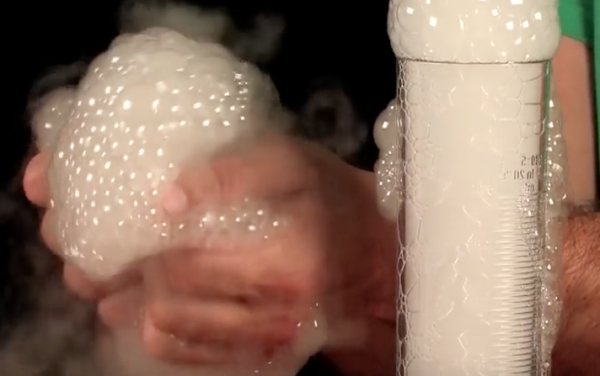
■ Key Vocabulary
• Bubble 거품, 공기방울
• Elusive 쉽게 빠져나가는, 잡기 힘든
• Grasp 장악하다
• Graduated cylinder 눈금 실린더
• Similar 비슷한
• Produce 만들어 내다
• Column 기둥
• Explosion 폭발
• Carbon dioxide 이산화 탄소
• Water vapor 수증기
■ To watch the experiment video, please go to : 과학실험 비디오
http://blog.naver.com/handsonenglish (사진 및 내용 출처: https://www.stevespanglerscience.com)
<김광미(Kwangmi Kim Shin)/TCIS(대전국제학교) ELL Coordinator/미국 존스홉킨스 교육대학원 석사/미국 매릴랜드주 몽고메리카운티 공립학교 ESOL교사>


